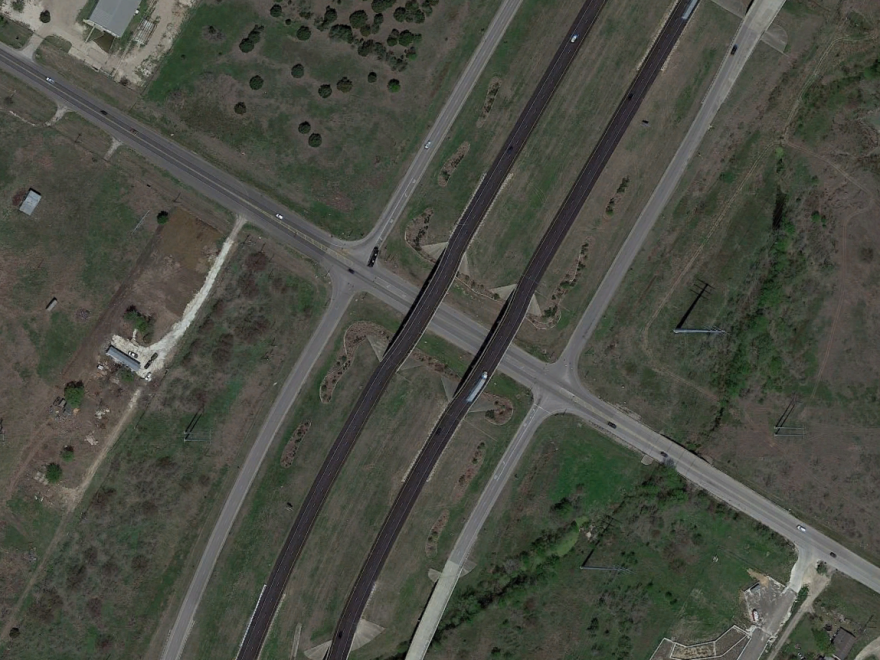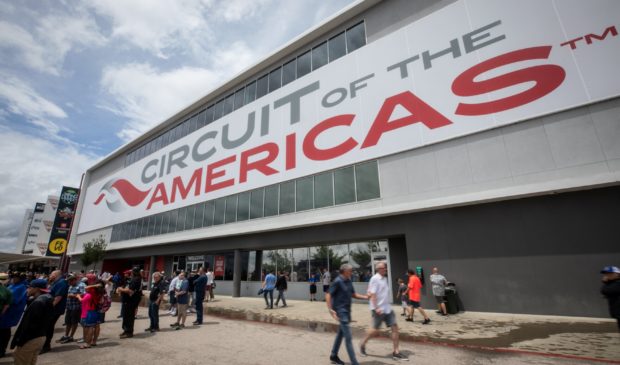The 1,500-acre venue has also spent the last decade infuriating many of those same fans when they become ensnarled in the periodic traffic jams that happen when thousands of vehicles are crammed down country roads in rural Travis County.
The traffic debacle around a Rolling Stones concert last year caused such an uproar, it sparked a new urgency about addressing transportation problems and disability access issues at COTA. While there have been notable infrastructure improvements in recent weeks, some of the biggest changes to the surrounding transportation infrastructure could still be years away.
‘Start Me Up’
By most accounts, the Rolling Stones put on an amazing, well-produced show – if you could get in. Some concertgoers told KUT the traffic was so bad they couldn’t access the venue.

When the show ended, the problems continued.
“We reached this one parking lot and we just stayed there for like an hour and a half. Not moving at all,” said Andrea Cardenas, a St. Edward’s University student who attended the show with her dad last November.
“We were seeing people sitting against the gate just sleeping or kind of giving up, because people were really not able to get (Uber or Lyft) rides,” she said. “I don’t know if I would want to go again if the traffic situation would be like that.”
Her experience was far from isolated.
In their only public statement about the fiasco, COTA officials accepted no blame and offered no apology to Rolling Stones fans. Instead, COTA’s statement blamed worker shortages by outside staffing companies and the Waze app for “turning heavy traffic into a mess.”
COTA’s defensive response infuriated fans even more. The anger was so visceral it reverberated inside Austin’s City Hall.
Weeks after the concert, City Council used its leverage over COTA to require quarterly meetings with local officials on the status of infrastructure upgrades around the venue. COTA has to get city approval to apply for subsidies from the state’s event trust funds program. Council attached a list of requirements to that permission slip.
“It was important to me that the city of Austin took action,” said Vanessa Fuentes, a City Council member who introduced the item and whose district includes Circuit of the Americas. “We have to think about the safety of our community.”
The first quarterly update, issued ahead of schedule on March 4, revealed COTA had hired business consultant J.L. Powers & Associates to help track down local, state and federal funding that could help pay for transportation and safety upgrades.

Some progress is being made, even if it might seem to be happening at a glacial pace.
What is being fixed?
Circuit of the Americas is fed by two roads from State Highway 130: FM 812 and Elroy Road.
Travis County just weeks ago finished widening Elroy Road from two lanes to five, including a middle turn lane. The project spanned about 1 mile west from Circuit of the Americas Boulevard to the already widened section of Elroy Road that connects to SH 130.

FM 812 falls under TxDOT’s jurisdiction. The two-lane road is slated to be widened to four lanes, but contractors won’t even be able to bid on the project until 2030 under the regional transportation schedule by the Capital Area Metropolitan Planning Organization.
CAMPO, which is governed by a 22-member panel that includes Austin City Council members, could vote to fund the project sooner. Fuentes says she’s spoken with her Council colleagues on CAMPO about advancing funding for FM 812.
“The power is in CAMPO’s hands,” she said.
Right now, there are no plans to add sidewalks and bike paths along FM 812. TxDOT says a shared-use path for pedestrians and cyclists could be built as part of the FM 812 widening project planned for the next decade.

But a smaller, short-term effort to fix FM 812 is coming soon. TxDOT is planning to repave and re-stripe a section of the road to add a center turn lane.
That $1.2 million project will span from FM 973, which is west of SH 130, to Elroy Road east of Circuit of the Americas. The project is scheduled to start this month and should take about two months to complete, TxDOT said.
Longer term, TxDOT still plans to build a new segment of FM 812 from FM 973 to U.S. Highway 183. But that’s in the early stages.

Construction is slated to start later this year on traffic signals at SH 130 at FM 812, one of the area’s busiest intersections during major events. Right now, there are just blinking yellow lights indicating drivers should slow down and proceed with caution.

Another traffic signal is under construction at Elroy Road and Circuit of the Americas Boulevard, according to a quarterly update from COTA to City Council.
Mobility problems inside COTA
Among the 14,000 fans watching as 78-year-old Mick Jagger strutted the stage at COTA’s Germania Insurance Amphitheater was the local tax man.
Bruce Elfant has been the Travis County tax assessor-collector and voter registrar since 2012. On that particular night, he happened to be on crutches, recovering from a broken ankle.
Things did not go well.
Elfant said upon his arrival, the ADA accessibility tent near the gate was unstaffed. No wheelchairs were available. On his way out, Elfant struggled on crutches to find transportation help getting back to his car.
“We witnessed other people with disabilities who were visibly upset at being told that they would not be transported back to their vehicles until the venue was emptied out,” Elfant wrote in a letter to COTA’s chief financial officer, Anna Panossian.
Elfant said because of the lack of help at the venue, he was forced to walk on crutches more than allowed by his doctor. Both feet became seriously swollen.
In his letter to Panossian, Elfant called for the creation of a disability access task force. COTA did exactly that, creating a committee that includes Elfant, representatives from the Coalition of Texans with Disabilities, ADAPT and two members of the Austin Music Commission.
“I’ve been around a while, so this can turn dark in a hurry. But I’m optimistic and hopeful that some good things are going to come out of this,” Elfant told KUT.
The task force had its first meeting in early March and got a tour of the COTA facility. Some members said they were encouraged by the attitude of COTA staff.
“They really took the problems that they encountered very seriously,” Austin Music Commissioner Oren Rosenthal told the commission at its last meeting in March. “When we talked about that Rolling Stones concert, they were embarrassed. They said, ‘Please don’t judge us by this Rolling Stones concert.'”
“PR-wise, it really gave them a black eye, but just personally as professionals, they felt that they had performed poorly, and they take that very personally,” he said.
COTA officials declined repeated requests to be interviewed for this story.
What about Cap Metro?
Could public transit help solve some of these transportation problems around Circuit of the Americas?
After the Rolling Stones snafu, the statement from COTA staff – the one that sought to deflect blame – pointed the finger at Capital Metropolitan Transportation Authority, among others, saying the regional transit agency should “heed the calls” of local elected officials for more public transportation in the area.
Capital Metro officials were surprised to read the statement, because COTA officials had not reached out to the transit agency for help with the event.

Existing demand doesn’t justify a regularly scheduled fixed-route service to Circuit of the Americas, Capital Metro said, given the pressing demands across other parts of its service area.
Capital Metro says providing shuttle service to COTA doesn’t make sense either. Because Capital Metro receives grants from the Federal Transit Administration, it’s severely restricted from competing with private charter bus companies taking groups to COTA.
Why not just ride a bike?
While it is theoretically possible to ride a bike from Austin to Circuit of the Americas, a 14-mile ride from downtown, the infrastructure is not exactly hospitable to cyclists.

Austinite Tyler Markham participated in a “bike night” that happens most Tuesdays at COTA, giving cyclists a chance to cruise the 3.41-mile racetrack. He took the bus as far as he could and biked the rest of the way.
But riding home to East Riverside in the dark was more perilous than he realized, especially along miles of county roads.
“There’s a few stretches where I had to bike on 50-, 60-mile-an-hour roads that didn’t have shoulders,” Markham said. “Definitely taking your life into your hands a little bit trying to do that … feeling the whoosh of cars going by a couple feet away from you.”
TxDOT “does not have a current construction project for shared-use paths,” the agency said. But they could be built as part of the FM 812 widening project planned for the early 2030s.
The new Elroy Road improvement by Travis County includes a sidewalk and bike lane.
Can anything else be done?
Besides improving infrastructure, COTA organizers could have “soft endings” after concerts – smaller events or attractions that give people a reason to stick around rather than making a mad dash for their cars, said Kara Kockelman, a professor of transportation engineering at UT Austin.
COTA announced plans last week to build a “massive amusement park” with more than 30 rides and two large roller coasters, which could give people a reason not to leave right after a show.

Communication is also important. Providing a clear expectation that transportation will be difficult, using more electronic road signs to convey information about traffic flow and road closures, and printing warnings about potential mobility problems in a large font on tickets could help, she said.
“If people are just like, ‘Yeah, I’ll just read a book in my car and wait for this to pass,’ I think that would be helpful,” she said.
But there are no easy substitutes for improved infrastructure.
“Nobody wants to do anything in the middle of the night except drink or sleep,” Kockelman said. “It is a multi-hour exit.”






